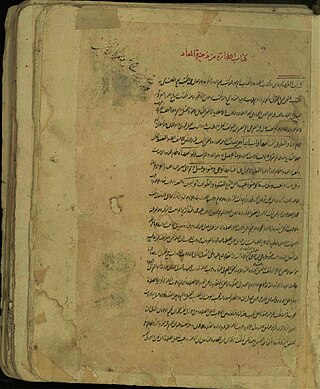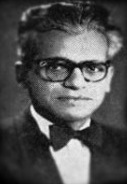
Khuzestan province is one of the 31 provinces of Iran. It is in the southwest of the country, bordering Iraq and the Persian Gulf. Its capital is Ahvaz and it covers an area of 63,238 square kilometres (24,416 sq mi). Since 2014, it has been part of Iran's Region 4.

Ahvaz is a city in the Central District of Ahvaz County, Khuzestan province, Iran, and serves as capital of the county, the district, and the province. It is home to Persians, Arabs, Bakhtiaris, Dezfulis, Shushtaris, and others. Languages spoken in the area include Persian and Arabic, as well as Luri (Bakhtiari) and different persian dialects such as Dezfuli, Shushtari and etc. Ahvaz's population is about 1,300,000 and its built-up area with the nearby town of Sheybani is home to 1,136,989 inhabitants.

The Shāh Abdol-Azīm Shrine, also known as Shabdolazim, located in Rey, Iran, contains the tomb of ‘Abdul ‘Adhīm ibn ‘Abdillāh al-Hasanī. Shah Abdol Azim was a fifth generation descendant of Hasan ibn ‘Alī and a companion of Muhammad al-Taqī. He was entombed here after his death in the 9th century.

Ahmad Hokmabadi Tabrizi, later known as Ahmad Kasravi, was a pre-eminent Iranian historian, jurist, linguist, theologian, a staunch secularist and intellectual. He was a professor of law at the University of Tehran, as well as an attorney and judge in Tehran, Iran.

Shushtar is a city in the Central District of Shushtar County, Khuzestan province, Iran, and serves as both capital of the county and of the district.

Ayatollah Mohammad Reza Mahdavi Kani was an Iranian Shia cleric, writer and conservative and principlist politician who was Acting Prime Minister of Iran from 2 September until 29 October 1981. Before that, he was Minister of Interior in the cabinets of Mohammad-Ali Rajai and Mohammad-Javad Bahonar. He was the leader of Combatant Clergy Association and Chairman of the Assembly of Experts and also founder and president of Imam Sadiq University.
Jaʽfar, meaning in Arabic "small stream/rivulet/creek", is a masculine Arabic given name, common among Muslims especially Arabs.

Ayatollah Sayyid Mohammad-Ali Mousavi Jazayeri is an Iranian Twelver Shia cleric, who has been appointed as the representative of Vali-Faqih in Khuzestan province by the order of Sayyid Ruhollah Khomeini, who was the previous Supreme Leader of Iran.
Ayatollah Seyyed Haj Muhammad-Hassan Jazayeri was from Khuzestan and he was a direct descendant of the Islamic prophet, Muhammad and was a descendant of Seyyed Nematollah Jazayeri who started the name Jazayeri 1640 (D.1700). Ayatollah Seyyed Haj Muhammad-Hassan Jazayeri was born in 1270 (1892) in the city of Qom, Iran. He started reading and studying the Quran at the age 5 as his father was a Grand Ayatollah Seyyed Mehdi. He learned several languages including Arabic and English by the age of 21. He was a teacher at a religious school called Elmia in Qom. He was a classmate of Ayatollah Khomeini when at quran school. At the age of 40, he was invited to Ahvaz to be the Supreme Religious leader of all the Imams of Khuzestan. He set the times of prayers (Aathaan) for Khuzestan. He had 5 children, 2 boys and 3 girls. He was very respected by the Shah of Iran. He led a very spiritual life and he was a very important Ayatollah in his time.

Seyyed Nematollah Jazayeri was a prominent Shia scholar born in 1640 and died in 1700, in one of the islands around Basra. He was one of the grandchildren of Musa al-Kadhim. His paternal lineage is as follows: Seyyed Ne'mat Allah son of Seyyed Abd Allah son of Mohammad son of Hossein son of Ahmad son of Mahmoud son of Ghias Aldin son of Majd Aldin son of Noor Aldin son of Saad Allah son of Issa son of Musa son of Abdallah son of Musa al-Kadhim.

Sheikh Jafar ibn Hussein ibn Ali Shooshtari was a prominent Shia scholar from the city of Shooshtar.
Seyyed Mohammad Jafar Moravej whose complete name/fame is "Seyyed Muhammad Jafar Jazaeri Moravej al-Shariah", was an Iranian Shia scholar who was born in 1910 and died in 1999, in a religious family in Shushtar. His father was Seyyed Muhammad Ali Moravej, and he is among the descendants of Seyyed Nematollah Jazayeri who was a prominent Shia scholar. This Shia scholar is commonly known as "Ayatollah Seyyed Muhammad Jafar Moravej".

Sayyid Abdul-Nabi Mousavi Fard is an Iranian Twelver Shi'a cleric, who has been recently appointed as the representative of Wali-Faqih in Khuzestan province and likewise as the Imam of Friday Prayer of Ahwaz by the order of Sayyid Ali Khamenei, the supreme leader of Iran, on 30 April 2019.

The Khamenei family or Khamenei dynasty is among the Iranian Azeri Sayyid families who claim to be descendants of the fourth Imam of Shia Islam, Ali ibn Husayn Zayn al-Abidin — according to the "Khamenei family tree". Their dwelling place(s) were/are in Azerbaijan (Iran), Najaf, Tafresh, etc.

Seyyed Ali Shafiei is an Iranian Twelver Shia scholar, who is a member of Assembly of Experts from Khuzestan province. He is a/the son of Seyyed Mohammad Reza (Shafiei) who was from the known Islamic scholars of Khuzestan. Seyyed Ali Shafiei commenced his educations from Maktabkhaneh (Kuttab), and began to peruse Quran and Islamic issues. Afterwards, he entered a new school. Later on, he went to educate Hawzah lessons in the city of Ahwaz. Then, Seyyed-Ali departed to the Seminary of Najaf, in Iraq. After Najaf, he came back to Ahwaz; and was appointed as a/the Imam of Jama'ah in Ahwaz, and commenced to promote Islamic rulings.

Mohammad-Taqi Shoushtari, known as "Sheikh-e-Shoushtari" was an Iranian Twelver Shia scholar, who was born in 1903 in the city of Najaf, Iraq. Shoushtari's father is originally from Shoushtar and his mother was from Kerman. He was living in Najaf until the age of 7; afterwards came back to Shushtar.
Mirza Abolghasem Gilani, known as Mirza-ye Qomi, the author of the book of Qawanin al-Usul, was a Shiite jurist (Faqīh), mujtahid, fundamentalist (Usuli) and a religious reference (Marja') during the reign of Fath Ali Shah Qajar in the twelfth century AH. Mirza-ye Qomi was active and famous in poetry and calligraphy. He has left more than fifty thousand verses of poetry in Persian and Arabic, as well as writings in Naskh and Nastaliq scripts.

Mullah Mohammad Jafar Sabzevari was one of the Iranian scholars and clerics of the 12th century AH, the Imam of Friday Prayer of the Shah Mosque in Isfahan and the author of several books and treatises including "Nowruznameh" and "Ma'ad" which was compiled at the request of Shah Sultan Hussein Safavid.

Mohammad Bagher Sabzevari known as Mohaghegh Sabzevari was an Iranian Faqih and Shiite scholar from the 11th century AH, Shaykh al-Islām and the Imam of Friday Prayer of Isfahan.
Mir Seyyed Abd al-Latif Shushtari was an Iranian traveller from Shushtar, who is principally known for his travelogue Tohfat al-Alam.















